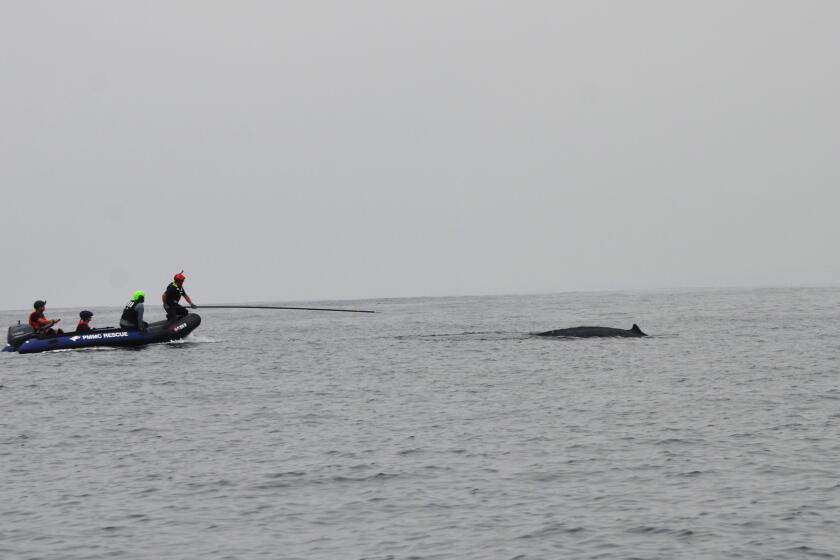Marine Agency Investigates Death of Whale Hit by Ship
The National Marine Fisheries Service is investigating whether a U.S. cargo ship violated the Endangered Species Act when it struck a 50-ton finback whale that was discovered dead this week outside the breakwater of Los Angeles Harbor.
A marine biologist who examined the carcass of the 45-foot whale said it is unclear whether the American President Line cargo ship killed the whale when it struck it Monday off the California coast, or if the mammal was already dead. The whale has since been towed offshore and sunk with weights.
The President Monroe, bound from Japan, sailed into the harbor with the whale pressed against its bow. The whale, which appeared to have died within 12 hours of the ship’s arrival at 10:30 a.m. Tuesday, slid off the bow as the vessel slowed to enter the breakwater, officials said. The mammal may have been pushed from the waters off Central California.
“The thing that needs to be determined is whether or not the ship struck the whale or basically picked up a dead whale and pushed it into the harbor,” said Ray Sautter, a National Marine Fisheries Service investigator. Authorities will also attempt to determine if the ship’s captain was negligent, he said.
Joseph Cordaro, a wildlife biologist for the national agency, said the position of the whale when the ship entered the harbor suggests the vessel struck and killed the whale, a healthy male less than 6 years old.
“If a ship comes in with a whale pressed against it like that, that’s pretty good evidence the whale was alive when it was hit,” Cordaro said. “To me, it means there was a strong impact.”
But shipping company spokesman Gil Roeder said the captain of the 35,000-ton, 900-foot ship did not notice anything amiss until he turned into the harbor’s main channel.
The finback, the second-largest whale species, is considered more endangered than the gray whale, but not as imperiled as the blue or humpback. An estimated 8,500 finback whales live along the Pacific Coast between Alaska and Baja California. Before they were hunted earlier this century, there were about 27,000 finbacks in the area.
Under the Endangered Species Act, the killing of any protected animal, whether by accident or intention, is punishable by fines up to $25,000. If investigators determine the killing accidental, however, it is unlikely the shipping line would be fined, officials said.
The Marine Fisheries Service reported that at least nine whales, at least five of them gray whales, have been struck and killed by ships off California since 1987. One accident in March, 1988, was witnessed by hundreds of schoolchildren, their family members and teachers, during a whale-watching tour a few miles outside the Port of Los Angeles.
Marine biologists say whales cannot easily detect a fast-moving ship coming straight at them because the noisiest part of the vessel is several hundred feet behind the bow. Most of the accidents occur during summer months when migrating whales feed off the coast of Southern California, said John Heyning, marine mammal curator for the Los Angeles County Museum of Natural History.
Because the number of whales reported killed by ships is much lower than the 50 or so whales that die in fishing nets off the coast every year, scientists do not generally consider shipping accidents a serious cause of mortality for large whales, Heyning said. But, he added, the statistics on shipping accidents could be inaccurately low because they do not reflect the number of whales that die later as a result of injuries.
“We need more information to find out if this is an odd occurrence or is it happening more frequently in this area,” Heyning said. “There’s not much a ship can do (to avoid a whale), but if it turns out this is a real bad area, the Coast Guard may be able to change its shipping lines.”
More to Read
Sign up for Essential California
The most important California stories and recommendations in your inbox every morning.
You may occasionally receive promotional content from the Los Angeles Times.






